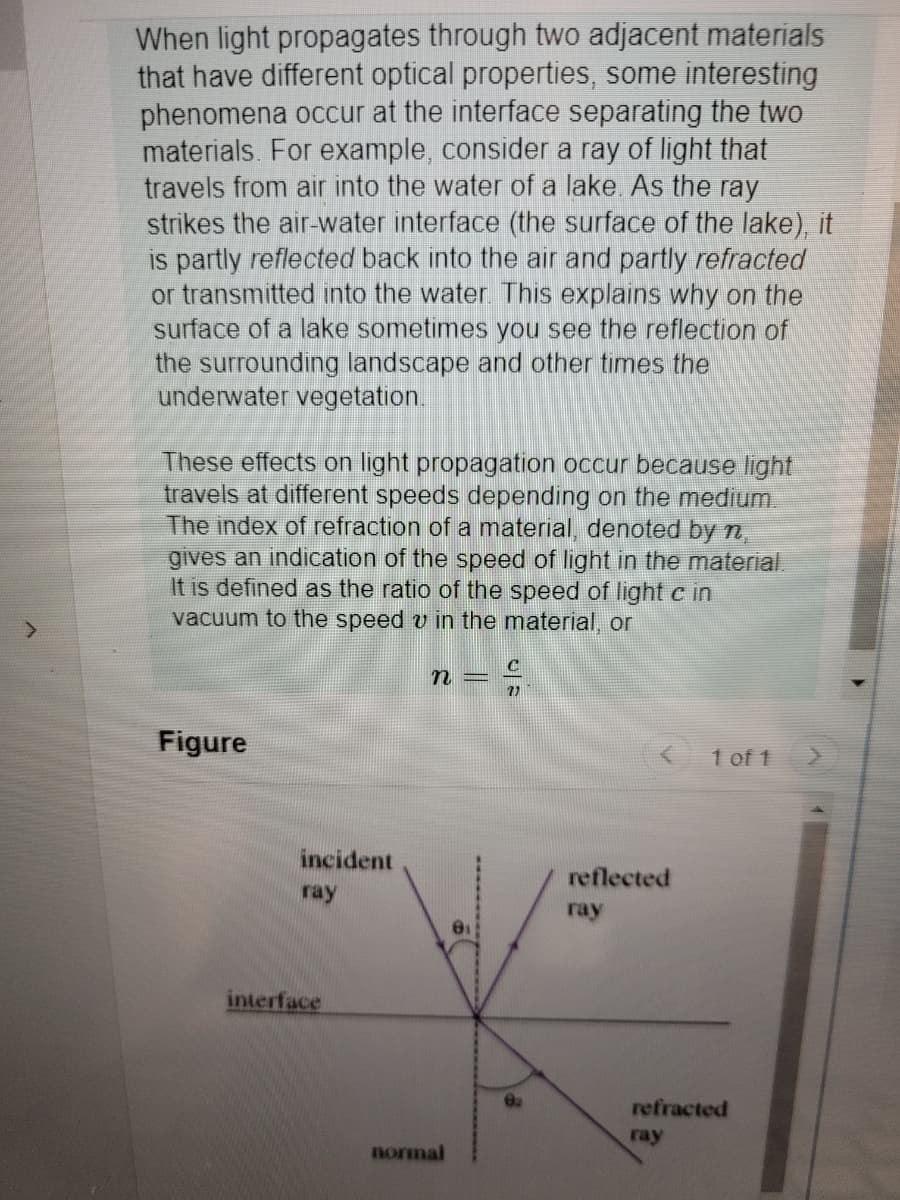Consider a ray of light that propagates from air ( n=1 ) to any one of the materials listed below. Assuming that the ray strikes the interface with any of the listed materials always at the same angle θ1 , in which material will the direction of propagation of the ray change the most due to refraction? What is the critical angle θcrit for light propagating from a material with index of refraction of 1.50 to a material with index of refraction of 1.00?
Consider a ray of light that propagates from air ( n=1 ) to any one of the materials listed below. Assuming that the ray strikes the interface with any of the listed materials always at the same angle θ1 , in which material will the direction of propagation of the ray change the most due to refraction? What is the critical angle θcrit for light propagating from a material with index of refraction of 1.50 to a material with index of refraction of 1.00?
University Physics Volume 3
17th Edition
ISBN:9781938168185
Author:William Moebs, Jeff Sanny
Publisher:William Moebs, Jeff Sanny
Chapter3: Interference
Section: Chapter Questions
Problem 77AP: A good quality camera “lens” is actually a system of lenses, rather than a single lens, but a side...
Related questions
Question
Consider a ray of light that propagates from air ( n=1 ) to any one of the materials listed below. Assuming that the ray strikes the interface with any of the listed materials always at the same angle θ1 , in which material will the direction of propagation of the ray change the most due to refraction?
What is the critical angle θcrit for light propagating from a material with index of refraction of 1.50 to a material with index of refraction of 1.00?

Transcribed Image Text:When light propagates through two adjacent materials
that have different optical properties, some interesting
phenomena occur at the interface separating the two
materials. For example, consider a ray of light that
travels from air into the water of a lake As the ray
strikes the air-water interface (the surface of the lake), it
is partly reflected back into the air and partly refracted
or transmitted into the water This explains why on the
surface of a lake sometimes you see the reflection of
the surrounding landscape and other times the
underwater vegetation.
These effects on light propagation occur because light
travels at different speeds depending on the medium.
The index of refraction of a material, denoted by n.
gives an indication of the speed of light in the material.
It is defined as the ratio of the speed of light c in
vacuum to the speed v in the material, or
Figure
1 of 1
incident
reflected
ray
ray
interface
refracted
ray
normal
Expert Solution
This question has been solved!
Explore an expertly crafted, step-by-step solution for a thorough understanding of key concepts.
This is a popular solution!
Trending now
This is a popular solution!
Step by step
Solved in 2 steps

Knowledge Booster
Learn more about
Need a deep-dive on the concept behind this application? Look no further. Learn more about this topic, physics and related others by exploring similar questions and additional content below.Recommended textbooks for you

University Physics Volume 3
Physics
ISBN:
9781938168185
Author:
William Moebs, Jeff Sanny
Publisher:
OpenStax

Principles of Physics: A Calculus-Based Text
Physics
ISBN:
9781133104261
Author:
Raymond A. Serway, John W. Jewett
Publisher:
Cengage Learning

Physics for Scientists and Engineers: Foundations…
Physics
ISBN:
9781133939146
Author:
Katz, Debora M.
Publisher:
Cengage Learning

University Physics Volume 3
Physics
ISBN:
9781938168185
Author:
William Moebs, Jeff Sanny
Publisher:
OpenStax

Principles of Physics: A Calculus-Based Text
Physics
ISBN:
9781133104261
Author:
Raymond A. Serway, John W. Jewett
Publisher:
Cengage Learning

Physics for Scientists and Engineers: Foundations…
Physics
ISBN:
9781133939146
Author:
Katz, Debora M.
Publisher:
Cengage Learning


Physics for Scientists and Engineers, Technology …
Physics
ISBN:
9781305116399
Author:
Raymond A. Serway, John W. Jewett
Publisher:
Cengage Learning

College Physics
Physics
ISBN:
9781938168000
Author:
Paul Peter Urone, Roger Hinrichs
Publisher:
OpenStax College